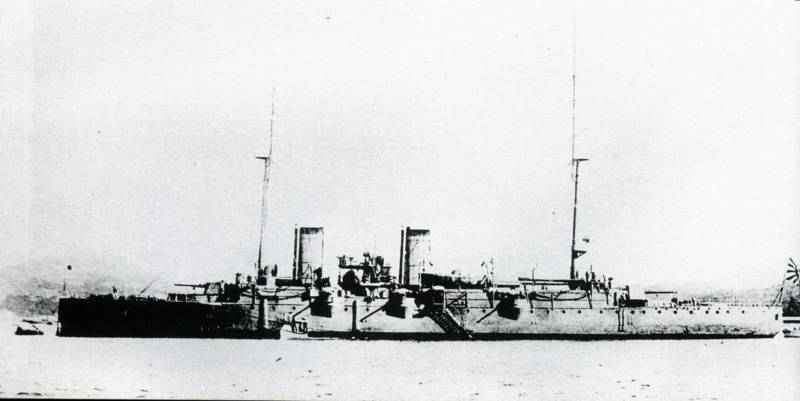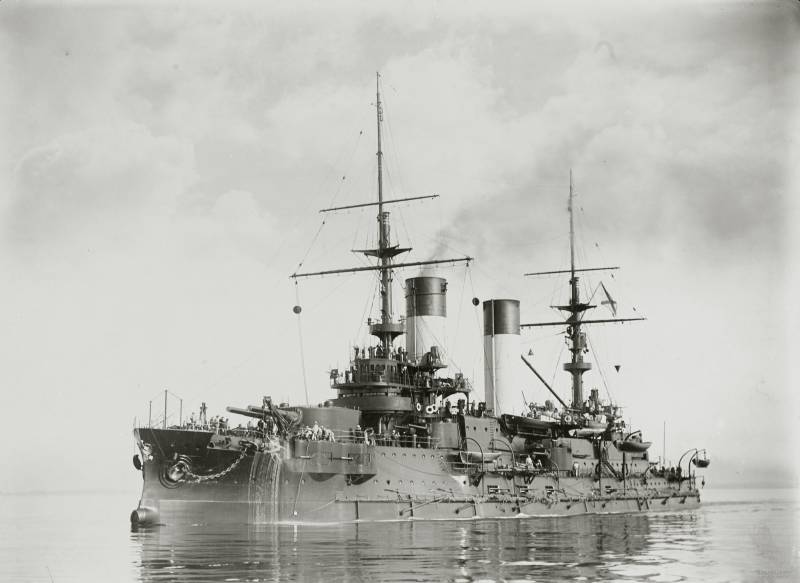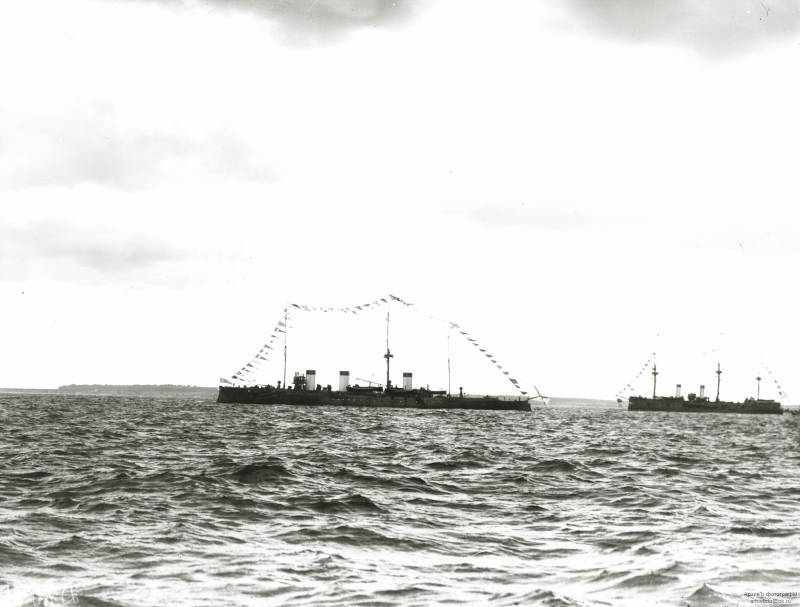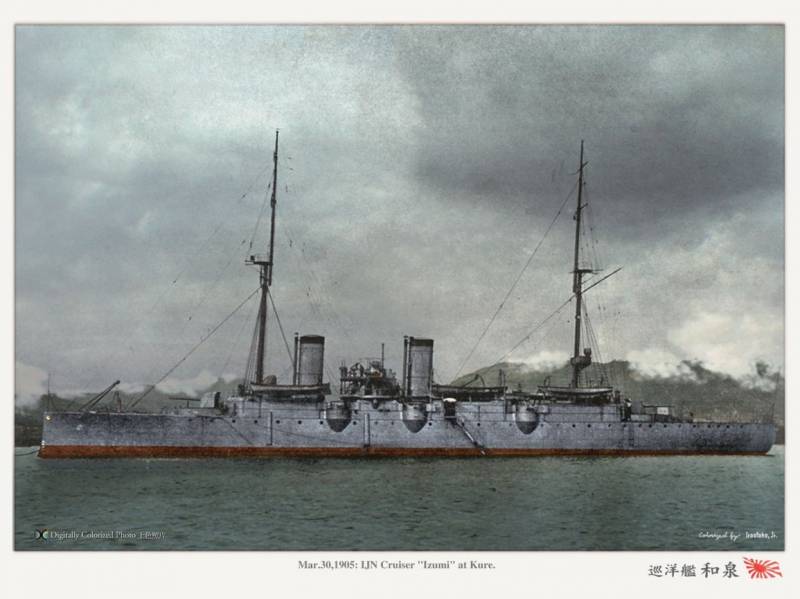Why ZP Rozhdestvensky not used cruisers "Pearl" and "Emerald" in Tsushima for other purposes?
It must be said that a detailed description of the events preceding the beginning of the battle will again lead us very far from stories armored cruisers 2-rank "Pearl" and "Emerald". However, the author does not see the possibility of omitting this period. The fact is that Z.P. Rozhestvensky before the collision of the main forces had several interesting opportunities to use his cruisers, and he, in fact, refused it. So, for example, both “Pearl” and “Emerald” were specialized ships for conducting reconnaissance in the interests of the main forces, but as such Z.P. Rozhestvensky did not use them. Why?
Alas, it is absolutely impossible to give any comprehensive answer to this question without an in-depth analysis of Z.P. Rozhdestvensky and his actions from the early morning of May 14 until the beginning of the battle of the main forces. In essence, the passive role of "Pearls" and "Emerald" during this period of time can only be explained if all the intentions of the Russian commander at that time are understood. Therefore, one should not think that the author, describing all this, deviates from the topic - on the contrary!
Main events of the first half of the day 14 May
Izumi discovered the Russian squadron on 06.18 in Russian time, and at about the same time it was discovered by itself. In this case, on our ships, the Japanese cruiser was observed poorly, occasionally losing sight of, and Z.P. Rozhestvensky believed that the Japanese cruiser did not come closer to our ships than on the 6 miles. The Japanese themselves believed that they were held in 4-5 miles. Most likely, the distance between the Izumi and the Russian fleet was maintained at the limit of visibility, when the opponents could barely watch each other.
Around 07.00, the reconnaissance detachment, which was marching in the head of the Russian squadron consisting of Svetlana, Almaz and the auxiliary cruiser Ural, moved to the rear of the Russian system, and Pearls and Emerald moved forward. It was perfectly logical, if not for the extremely small distance separating them from the lead ships of the squadron. According to the commander of "Pearl", his cruiser took up a position in 4 points from the squadron course (45 degrees) and only in 8 cable from "Suvorov". Thus, it turns out that "Pearls" pushed forward a distance of less than a mile! And even then - not for long, because somewhere in the interval from 09.00 to 11.00, on a signal from Suvorov, Pearls took a place on its right traverse. "Emerald" did the same evolution as the "Pearl", but on the other side of the course of the squadron, that is, to the left of its left column, which led the "Emperor Nicholas I".
According to the report of P.P. Levitsky, commander of the "Pearl", on 08.40 his cruiser drove away the Japanese junk that was heading to Tsushima Island.
Around 09.40, that is, 3 hours after the enemy warship was discovered on the Russian squadron, the 3-I combat squadron appeared from the north (“Chin-Yen”, “Matsushima”, “Itsukushima” and “Hasidate”). Japanese forward-looking 3 units found the Russian squadron a bit earlier - in 09.28. This Japanese detachment also kept a distance, limited to observation, which, however, is completely unsurprising.
Seeing a detachment of the Japanese, ZP Rozhestvensky decides to start rebuilding into battle order, but he does it very slowly. At about 09.45 (later 09.40 but before 10.00), the right column, that is, the 1-th and 2-th armored troops receive the admiral's order to increase the speed to 11 nodes, which is what they do. As a result, the right column of the Russian fleet gradually overtakes the left column and transports.
At some point in time, the Pearls discovered a Japanese steamer ahead of itself, crossing the course of the Russian squadron, and at full speed went to it for "clarification", making a warning shot from an 47-mm gun. The steamer stopped and tried to lower the boat, but because of the rather strong excitement, it broke against his own hull. “Pearls” approached the ship on a Polkabeltov, the Japanese were visible, kneeling and praying, as well as making other gestures, which the cruiser commander regarded as a plea for mercy. However, offending the non-combatant was not part of the plans of P.P. Levitsky - explaining (with signs) to the crew that the latter should leave, where he came from, he achieved that the steamer quickly departed in the opposite direction. Then "Pearl" returned to its designated place. Unfortunately, when exactly this happened, it is completely unclear: the official history reports that it was in 10.20, but PP himself. Levitsky reported in his report about the fight that he was heading to 09.30 to intercept the steamer. And he finally confused the case, indicating in the testimony of the Investigation Commission that "Pearl" intercepted a Japanese ship in 11.00!
Further timekeeping, alas, also suffers from inaccuracies. Our official historiography reports that in 10.35, destroyers on the right and left ahead of the course of the Russian squadron were found on the Russian squadron. In fact, they were not there, but by an alarm signal, the Emerald moved from the left traverse of the squadron to its right side and entered the Pearl wake, and the destroyers of the 1 squad joined them. Thus, a small detachment of light forces was ready at any moment to move forward, if the Japanese destroyers launched an attack - which, naturally, would not follow. A little later, the 3-y combat unit of the Japanese was lost sight of, so that by 11.00 was given an order to dine open.
It seems that everything is clear, but the problem is that the reports of the commanders of "Pearl" and "Emerald" directly contradict this conclusion of the workers of the historical commission. Both documents report that the Emerald moved to the right side of the Russian squadron later, during a short skirmish of our main forces with Japanese cruisers.
That is, if, for the reconstruction of those distant events, we still take the reports of commanders as a basis, then this was the case. In 11.05, the new Japanese scouts appeared - "Chitose", "Kasagi", "Niytaka" and "Tsushima", but then again disappeared in the fog. And at the same time, the right column of the Russian squadron took the rumba to the left on the 2 - it had already moved forward enough to head the ships of N.I. Nebogatov. However, the Japanese ships again appeared in 11.10, both units together. Five minutes later, the Russian squadron was lined up in battle order - the wake column, and a random shot was fired from the squadron battleship Oryol. A short skirmish ensued with the Japanese cruisers, while the Russians believed that the distance between the fighting was 39 cable. It is, of course, about the distance to the "Suvorov", it is clear that for other ships of the long wake column it could be different. The Japanese believed they had opened fire from a distance of approximately 43 cable. There were apparently no hits on both sides, and the Japanese immediately retreated, turning the X-ROM points (8 degrees) to the left, so that the fire was soon stopped by both sides.
So, the commander of "Emerald" reported that his cruiser, at the beginning of the shootout, that is, in 11.15, was still on the left traverse of the Emperor Nicholas I, however, when he started the fight, in full accordance with his previous by order, he took a position on the right beam of the Oslyab, that is, so that the formation of the Russian battleships was between the Emerald and the enemy. During the execution of this maneuver, the cruiser was fired from aft guns. The report of the commander of "Pearl" confirms his words.
According to the author, we are most likely talking about some kind of delusion of the historical commission, because the only way to somehow reconcile both versions is that the Emerald, indeed, in 10.35, goes to the right traverse of the Russian squadron, and columns, then, for some reason, returned to the "Emperor Nicholas I." But it looks nonsense, and besides - not having confirmation.
The shootout took no more than 10 minutes, that is, up to about 11.25, and then the Japanese cruisers were out of sight. Then, at 11.30, at Zhemugue, they saw, or thought that they saw, enemy cruisers crossing the course of the Russian squadron from left to right. “Pearls” gave them a shot from the nose 120-mm gun, wishing to attract the admiral’s attention, but received no instructions in response to this.
For a while, nothing noteworthy happened, but in 12.05 the Russian squadron, believing that it had reached the middle of the eastern part of the Korean Strait, turned left and lay on the famous NO23 course. At the same time, the Japanese squad of 3 was on the right of the new course of the Russian ships, and now they were coming closer, so the Japanese commanders preferred to retreat.
Taking advantage of the fact that the Russian squadron was left without supervision for a while, and assuming that since the Japanese patrols were retreating to the north, the main forces of Kh. Togo and Z.P. Rozhestvensky decided to rebuild the ships 1-th and 2-th armored units (and not just 1-th, as it is written in a number of sources) with front systems, but instead, for reasons that we consider below, the squadron was again in two march columns. However, this system was different from the marching one, because now the 2 armored detachment led by Oslyabye was not in the right column, behind the 1 armored detachment, but headed the left column. During this unsuccessful attempt to rebuild, it seems that the Emerald left the traverse Oslyabi and moved behind the Pearls, which resulted in an improvised detachment of light forces from the two cruisers and the 1 of the destroyer detachment on the right flank of the Russian squadron. At the same time, the head “Pearl” followed the traverse of the “Suvorov”. And so, in general, it lasted until the meeting of the main forces of ZP Rozhestvensky and H. Togo.
Oddities in the actions of the commander
Of course, to the above, a lot of different questions arise. Brief summary of the above is as follows: the commander of the Russian squadron Z.P. Rozhestvensky, finding in the early morning that the Japanese cruiser was watching the forces entrusted to him, made no effort to destroy it, or at least to drive it away. Although at his disposal were quite high-speed cruisers: "Oleg", "Pearl", "Emerald", and, perhaps, "Svetlana". He knew that the Japanese were actively talking on the radio, but he explicitly forbade them from interfering with this. Z.P. Rozhestvensky continued to march for a long time, although at any moment one could expect the appearance of the enemy, and when he nevertheless began rebuilding into a wake column, he did it very slowly, so that the rebuilding itself took him an hour or maybe even more (not an hour and a half but about that). Then, when the squadron finally rebuilt, he soon for some reason broke the resulting wake column with such difficulty and again divided its battleships into unequal parts on the 2, with the strongest 1's armored detachment going now in proud loneliness. Z.P. Rozhestvensky did not order to drive away the enemy cruisers, the skirmish began by chance, and not at his command. And, among other things, the Russian commander for some reason did not try to push his high-speed cruisers forward for reconnaissance!
As we said earlier, Z.P. Rozhestvensky was much reproached for not making an attempt to conduct long-range reconnaissance by cruisers, which meant sending them several dozen or even a hundred miles ahead. He replied that such use of cruisers was completely meaningless for him, since he could not give any new information about the Japanese, which he would not know and so. But the forwarding of such a detachment forward could have led to its death, since the cruisers 2 and 3, TOE, were much inferior to those of the Japanese. In addition, the appearance of such a detachment would have warned the Japanese about the imminent appearance of the Russian squadron, that is, it alerted them ahead of time. The reasons for the Russian commander were recognized by the authors of the Russian official history of the Russian-Japanese war at sea as absolutely true, and the idea of long-distance intelligence was counterproductive. And this is despite the fact that the official historiography, in general, is not at all inclined to defend Z.P. Rozhestvensky - claims from the historical commission to him are more than enough.
But Z.P. Rozhestvensky, rejecting long-range intelligence, did not organize close-range intelligence either, did not advance his cruisers, and at least the Pearl with the Emerald was not several miles ahead. And these are the compilers of the “Russian-Japanese War 1904-1905” considered a very gross mistake by the commander. The authors of this respectable work quite rightly point out that the rebuilding from marching to battle order is Z.P. Rozhdestvensky would need, given the time required to feed signals, of the order of 20 minutes, while his squadron would follow at a speed of the order of 9 nodes. But during this time, the Japanese squadron, if it were suddenly ahead of the Russian forces, could move towards our ships at a speed of 15 nodes. Accordingly, the convergence rate could be up to 24 nodes and in 20 minutes both squadrons, following towards each other, would converge on 8 miles. And the visibility limit that morning barely reached 7 miles - it turns out that if the Japanese had rushed towards the Russians immediately after visual detection of the latter, ZP Rozhestvensky, in principle, could not have time to reorganize, and the Japanese fleet would have fallen upon a squadron that had not finished rebuilding!
Thus, we see that in the first half of 14 May, another Russian commander could have found a lot of work for “Pearls” and “Emerald”, but Z. P. Rozhdestvensky kept them in close proximity to the main forces. Why?
Let's start with "Izumi".
Why ZP Rozhdestvensky not ordered to sink "Izumi"?
Of course, it would be possible to send a detachment of the most high-speed cruisers to chase the Izumi, but what would it be? The problem was that, according to the Russian commander, the Japanese cruiser was about 6 miles from its flagship.
Suppose that Z.P. Rozhestvensky would send the most high-speed cruisers, the Pearls and the Emerald, to destroy the Izumi. In fact, this idea is not as absurd as it may seem at first glance, because Izumi was lighter than Russian cruisers - its normal displacement did not reach 3 000 t. But the armament, although it was somewhat stronger than that of a single Russian cruisers - 2 * 152-mm and 6 * 120-mm guns against 8 * 120-mm guns on the "Pearl" or "Emerald", but still the number of trunks twice lost to both cruisers.
Suppose that both Russian cruisers gathered in a small detachment and managed to get close to the Japanese ship on the same 6 miles before the commander of Izumi understood what was going on, and began to retreat. But Izzumi's passport speed was 18 nodes. And, if we assume that Pearl and Emerald could give 22 knots, and Izumi could not develop a full turn, having no more than 16-17 nodes, then in that case the ships would approach the speed of 5- 6 miles per hour. Thus, in order to at least get closer to the distance from which one could expect to inflict any damage on the Japanese cruiser (30 cables), the most high-speed Russian cruisers would need half an hour, for which they would have retired from the squadron to 11 miles, that is, they would have gone beyond the line of sight and were left to themselves. But even then you can talk not about a decisive fight, but only about shooting in a pair of 120-mm guns. In order to get close, it is enough to fight in full board, it took almost as much more time. Not to mention that Pearl and Emerald could not support the 22 node for a long time (actually, the admiral doubted that they and 20 would be able to withstand for a long time), and Izumi might have been able to and more 17 nodes.
Was it possible to count on the fact that behind the Izumi, in 20-30 miles away there are no other Japanese ships? Especially considering the fact that the entire experience of the Port Arthur siege suggested that the Japanese use not single intelligence officers for reconnaissance, but entire detachments? Could Russian cruisers manage to return to the squadron after the battle, even if successful, having overcome the 20-30 separating them for miles, or even more, because the squadron, of course, should not have waited for them, but continued to go to Vladivostok? And if two Russian cruisers were cut off from the main forces by a large detachment of enemy cruisers? Small armored cruisers did not have great combat stability, and the occasional successful hit by the Japanese could reduce the course of one of them. What was to be done in this case - to throw the “wounded animal”, one might say, to certain death?
As a matter of fact, it was probably these reasons that Z.P. Rozhestvensky, when he said: “I did not order the cruisers to drive it away and believed that the commander of the cruisers did not make the order on their own, sharing my thoughts about the possibility of being carried away by the pursuit in the direction of the enemy’s superior forces, which were nearby, obscured.”
And it's not that Rear Admiral OA Enquist was allegedly in some kind of “warlike heat”, over which the authors of the “Russian-Japanese War 1904-1905 years” allowed themselves to joke, and that having started an artillery duel with Izumi and beyond the appearance of the main forces of the squadron Without watching anyone around, it would be very easy to get carried away, especially if the battle would have been in favor of the Russians, and being too distant from the squadron - the result of which could be the death of a just victorious detachment.
We talk a lot about the fact that the death of the Izumi would have a huge moral impact on the squadron - and against this it is difficult to argue anything. But there was no chance of sinking it in view of the squadron, and sending the cruiser to chase was too great the risk that the chase would either end up retreating before the enemy’s superior forces, or else lead to damage and death of the Russian ships. And besides, we should not forget another important aspect.
The ships have come a long way, while the same Emerald and Pearl did not pass the full test cycle. A high, close to maximum stroke could easily break in the car. And let's imagine a picture - the two best squadron fast-pacers rush to intercept the Izumi, he runs ... and suddenly one of the Russian cruisers loses his turn and stays behind. We can safely say that the morale of the squadron would not have raised a similar episode for sure. And if such a breakdown happened during the pursuit, outside the visibility of the squadron?
Here, of course, it is worth noting that the ships, in fact. went into battle, but in it, as you know, anyway, if necessary, it was required to develop high speed. But recall that the tasks that set Z.P. Rozhdestvensky, to his cruisers, “as specially”, did not demand from them excellent driving characteristics. In order to protect the transports and serve as repetitive ships under the main forces, as well as to repel possible attacks by the destroyers, cover the wrecked ships, even the 20-nodal speed was not really required. Yes, orders Z.P. Rozhdestvensky cruisers 2 th Pacific squadron were completely non-heroic and not too typical of their classic role, but they took into account the actual technical condition of the Russian ships of this class. Well, if some cruiser in the heat of battle and “flew” the car - well, then there was nothing to be done, what to be, not to be avoided. But it would not have made any special impact on the rest of the squadron - the rest of the crews in battle would have no time for that.
Nevertheless, the author of this article considers the decision of Z.P. Rozhestvensky leave alone Izumi erroneous. Of course, he had many reasons not to send the cruiser in pursuit of the Izumi, but he could have ordered, for example, to drive away the Japanese cruiser, not moving away from the squadron beyond the line of sight. And who knows, what if a “golden hit” would have caused Izumi to lose its course? In the end, the same "Novik" managed with a single hit of an 120-mm projectile to disable the "Tsushima"! And this Japanese armored cruiser was both larger and more modern than the Izumi.
Of course, sending “Pearls” with “Emerald” into battle, the commander to some extent risked the fact that one of them could have been hit by a “golden hit”, but in order to only drive away “Izumi”, it would be possible to use not "second-class" cruisers, but "Oleg" and "Aurora". These ships were significantly larger, and the chances that an accidental hit from a Japanese ship could damage them severely were extremely low. In addition, as the artillery platforms large cruisers were more stable than the Emerald and Pearl, so they had more chances to hit the enemy. Of course, the chances of dealing with the Japanese intelligence officer were regrettably small, but the spectacle of how Izumi runs into all shoulder blades would have a very beneficial effect on the fighting spirit if not the officers, then the sailors of the 2 and 3 of the Pacific squadrons.
So, with the description of the episode with Izumi, we are finished, but why is Z.P. Rozhdestvensky not put forward, at least for a few miles, "Pearls" and "Emerald" for near intelligence? After all, the only way he could gain time is that, when an enemy was found, he had time to reorganize into battle order.
The answer to this question will sound paradoxical, but, apparently, the early detection of the Japanese main forces was not at all part of Zinovy Petrovich’s plans, and moreover, it was in direct contradiction with them. How so? Alas, the volume of the article is limited, so we'll talk about it in the next article.
To be continued ...




Information